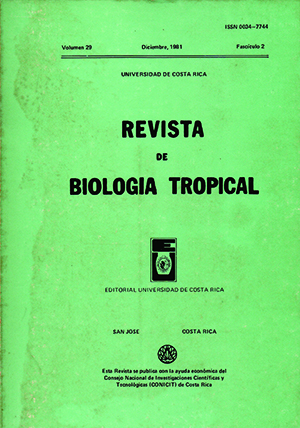Resumen
En un breve estudio experimental del comportamiento competitivo de abejas, se encontró que Apis mellifera (Apinae) europea obtenía el alimento más oportunísticamente que Trigona corvina (Meliponinae). Eliminación experimental de una gran porción de Baltimora recta (Compositae) visitada por ambas abejas causó un aumento de 44% en la presencia de A pis dentro de las áreas de estudio adyacentes de Baltimora y sólo un aumento de 17% de Trigona. Sin embargo, un análisis de variación demostró que la cantidad promedio de Apis subió significativamente pero no la de Trigona en áreas de estudio durante tres días después de la manipulación experimental. Apis visitó tres flores en un promedio de 15,1 segundos, comparado con 25,6 segundos por Trigona. Trigona corvina obtenía el alimento en grupos y sus individuos ocasionalmente atacaban a Apis, sin ningún efecto aparente. El comportamiento flexible de A. mellifera sugiere una ventaja competitiva comparada con T. corvina cuando escasean los recursos florales.
Citas
D'Arey , W.G. 1975. Flora of Panama. Ann. Missouri Bot. Gard., 62: 83-1321.
Feinsinger, P., & R.K. Colwell. 1978. Community organization among neotropical nectar-feeding birds. Amer. Zool., 18: 665-681.
Gary, N .E., P.C. Witherell, K. Lorenzen, & J .M. Marston. 1977. The interfield distribution of honey bees foraging on earrots, onion, and safflower. Enviran. Entomol., 6: 637-6 40.
Hubbell, S.P. , & L.K. Johnson. 1977. Competition and nest spacing in a tropical stingless bee community. Ecology, 58: 949-963.
Hubbell, S.P., & L.K. Johnson. 1978. Comparative foraging behavior of six stingless bee speeies exploiting a standardized resource. Ecology, 59: 1123-1136.
Inouye, D.W. 1978. Resource partitioning in bumblebecs: experimental studies of foraging behavior. Ecology, 59: 672-678.
Johnson, L.K. 1974. The role of agonistie behavior in the foraging strategies of Trigana bees. Ph.D. thesis, University of California, Berkeley.
Johnson, L.K. , & S.P. Hubbell. 1974. Aggression and competition among stingless bees: field studies. Ecology, 55: 120-127.
Johnson, L.K., & S.P. Hubbell. 1975. Contrasting foraging strategies and coexistence o f two bee species on a single resource. Ecology, 56: 1398-1406.
Karr, J .R., & F.C. James. 1975. Eco-morphological configurations and convergent evolution in species and communities. In M.L., Cody, & J .M. Diamond (eds.). Ecology and Evolution of Communities. Harvard University Press, Cambridge, Mass.
MacArthur, R.H. 1958. Population ecology of some warblcrs of northeastern coniferous forests. Ecology, 39: 599-619.
Michener, C.D. 1974. The social behavior of the bees. Harvard University Press, Cambridge, Mass.
Roubik, D.W. 1978. Competitive interactions between neotropical pollinators and Africanized honey bees. Science, 201: 1030-1032.
Roubik, D.W. 1980. Foraging behavior of competing A fricanized honeybees and stingless bees. Ecology, 61: 836-845.
Selander, R.K. 1966. Sexual dimorphism and differential niche utilization in birds. Condor, 68: 113-151.
Sokal, R.R., & F.J. Rohlf. 1969. Biometry. W.H. Freeman. San Francisco, Calif.
Wille,A. 1965. Las abejas atarrá de la región mesoamericana del género y subgénero Trigolla (Apidae -Meliponini). Rev. Biol. Trop., 13: 271-291.
Wille,A. 1976. Las abejas jicotes del género Melipona (Apidae: Meliponini) de Costa Rica. Rev. Biol. Trop., 24: 123-147.
Wolf, L.L., G.F. Stile s, & F.R. Hainsworth 1976. Ecological organization of a tropical highland hummingbird community. J. Anim. Ecol. 45: 349-379.
##plugins.facebook.comentarios##

Esta obra está bajo una licencia internacional Creative Commons Atribución 4.0.
Derechos de autor 1981 Revista de Biología Tropical


